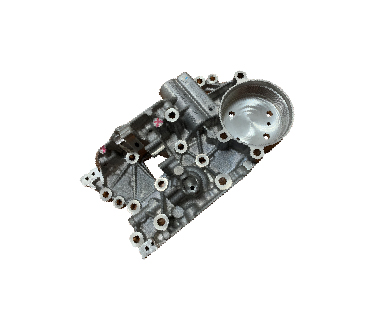Aluminum casting can not only improve the surface processing quality of the mold cavity, but also prevent the mold from cracking due to stress concentration. When the die is finished, the surface of the cavity should be polished and ground to make the surface roughness of the cavity less than 0.8 μ M. This time, let's understand the preheating requirements of aluminum castings
When the aluminum casting is used in the manufacturing of the electrode, the sharp edge around the electrode will be rounded to d1.5mm-2mm. There is no sharp corner transition in the die cavity after EDM, so as to avoid the crack failure at the sharp corner of the die. Correct and standard use of aluminum mold, supplemented by maintenance management, will prolong its service life.
The aluminum casting needs to be preheated before use. The aluminum mold should be preheated to a fixed temperature before use. Preheating can prolong the service life of the mold. The preheating temperature should be controlled at 250 ℃ - 300 ℃ for about 0.5h. It is forbidden to use molten metal (aluminum water) to directly preheat the mold, because the cold mold is directly in contact with the hot liquid metal, which is bound to be affected Thermal shock, resulting in thermal erosion, accelerates cracking and spalling caused by thermal fatigue.

In the continuous production, the temperature of the aluminum casting mold is often increased. When the temperature is too high, it will not only cause the liquid metal to produce flaring, but also slow the cooling of the casting, resulting in coarse grains and poor quality of the cast aluminum parts. Therefore, when the temperature of the aluminum casting mold is too high, cooling measures should be taken, usually using compressed air or water for cooling. The cooling system is generally designed for aluminum casting, It is strictly forbidden to use cold water to quench the mold in order to avoid the cracks caused by the cooling shrinkage of the mold, which will lead to premature failure and shorten the service life of the mold. Of course, proper spraying of paint in the use of the mold can not only prevent sticking to the mold, but also play a certain cooling role, which is beneficial to improving the service life of the mold.
After the aluminum casting is used, the maintenance and management of the aluminum casting, the mold cavity should be cleaned timely to remove the residual aluminum, and the rust prevention treatment should be carried out after cooling, and the warehouse should be placed flat, centralized management, for reuse. Aluminum mold is an important tool in motor manufacturing, which occupies a large proportion in the cost of motor manufacturing. Practice has proved that: using new die materials, reasonable forging and correct heat treatment are the key links to improve the service life of aluminum casting mold; at the same time, grasping the mold design, manufacturing, use and maintenance management and other related links, the service life of aluminum casting mold can be extended, and the cost of motor manufacturing will be reduced accordingly.
In the production process of automotive aluminum castings, it is inevitable that oxide impurities will appear. According to the different formation periods in the melting and casting process, they can be divided into primary oxide inclusions and secondary oxide inclusions. The primary oxide inclusions mainly refer to all the oxide inclusions formed before pouring molten aluminum.
The primary oxide inclusions in aluminum castings can be divided into two types according to their shapes. One is the large inclusions with uneven distribution in the macro structure. Such inclusions make the alloy structure discontinuous, reduce the air tightness of the workpiece, become the source of corrosion, significantly reduce the strength and plasticity of aluminum alloy, and often become the crack source of parts. The second type of oxide inclusions refers to small and dispersed inclusions Even after careful purification, the inclusions can not be completely removed. It increases the viscosity of liquid metal, reduces the feeding capacity of liquid aluminum during solidification, and is easy to cause shrinkage porosity of castings.
In the subsequent production process of aluminum castings, laser welding is often used. There are many problems in the process of laser welding of aluminum die castings. The main reason is that the aluminum alloy is a kind of non-ferrous metal, and it has strong reflection to various light during operation. As a kind of intense light beam, laser can easily cause reflection on the surface of aluminum alloy. In addition, the thermal conductivity of aluminum alloy makes it easy to reflect the laser or conduct the heat from the laser when welding with laser, which will eventually lead to the failure of aluminum alloy welding.
When welding aluminum alloy by laser, the laser power density of aluminum casting should be improved to prevent reflection or conduction. The density of aluminum alloy should be welded at extreme time, so as to avoid reflection and other problems.
Because of its liveliness and easy to be oxidized, a large amount of dust and water are easily attached to the surface of aluminum casting during operation. Therefore, in the welding process, the things attached on the surface are easy to stay on the surface of aluminum alloy with laser welding, which will affect the quality and welding effect of aluminum alloy. Therefore, before welding, it is necessary to clean the surface of aluminum alloy and remove the oil stain on the surface. At the same time, it is also necessary to clean the oxide film on the surface to prevent the explosion and other threats caused by oxidation during welding.
Contact person: Mr. Wang
Tel: 0512-52972252
Email: W wang@szypco.com
website: www.szypco.com
Address: No.10 WengZhuang Road, Shanghu Town, Changshu, Suzhou, Jiangsu Province


